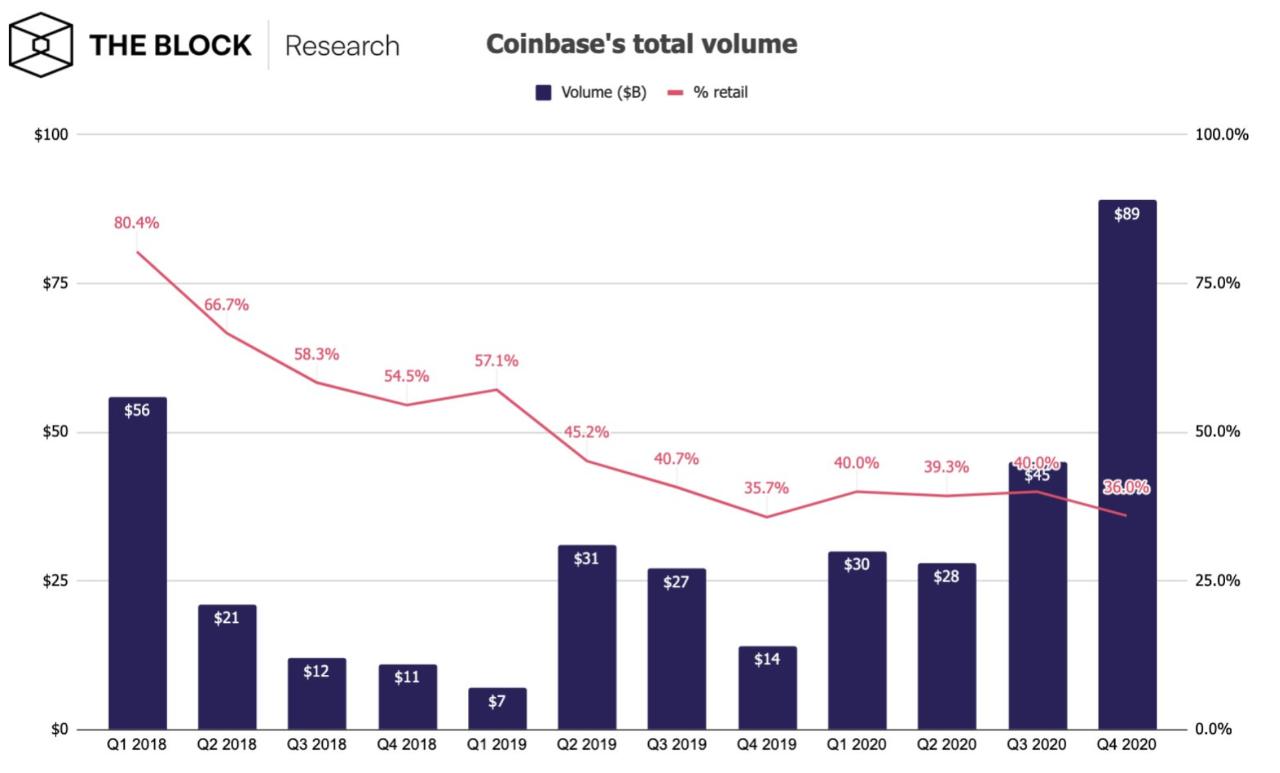Deconstructing Coinbase's IPO documents: Price-to-earnings ratio may exceed 300 times, a16z and USV become the biggest institutional winners
This article is an original piece by Chain Catcher, authored by Gu Yu.
Months after announcing its IPO news, Coinbase is now taking the final step toward going public. However, facing a market valuation expectation of over $100 billion, a price-to-earnings ratio exceeding 300 times, and the absence of a lock-up period for all stocks, Coinbase's upcoming stock price performance may have significant uncertainty. On February 25, Coinbase officially submitted its listing application to the SEC, planning to directly list its Class A common stock on the Nasdaq Global Select Market under the ticker symbol "COIN," with Goldman Sachs, Citigroup, and JPMorgan Chase serving as trading advisors. If successfully approved for listing, Coinbase will become the first major cryptocurrency exchange to go public in traditional capital markets, marking a milestone event in the cryptocurrency industry.
For many years, Coinbase has been regarded as the most influential player in the cryptocurrency market. Although its trading volume is not the highest among exchanges, it has gained significant recognition from industry insiders due to its compliance and professionalism, leading to high attention once its listing plan was announced. Currently, Coinbase is expanding its business in various areas, including asset custody, cryptocurrency payments, and venture capital, in addition to its core trading operations.
With the official release of the S-1 document submitted to the SEC, a wealth of financial information and details about the company has been disclosed. To delve deeper into Coinbase's development status, Chain Catcher has conducted a detailed study and analysis of Coinbase's S-1 document, extracting important information points and organizing them as follows:
1. Financial Data
According to the document, Coinbase's total revenue in 2020 was $1.277 billion, a 128% increase from 2019, with a net profit of $322 million and earnings per share of $1.58 for common shareholders, compared to a net loss of $30.4 million for the entire year of 2019.

In terms of revenue sources, approximately 85.8% of Coinbase's revenue comes from customer transaction fees; about 3.5% comes from subscription and service revenue, primarily from asset custody fees paid by customers; and approximately 10.6% comes from other income, which, according to the document, mainly refers to income earned by Coinbase from using its own held cryptocurrency to help customers complete transactions during unexpected interruptions in the trading system.
Regarding operating expenses, the largest portion is general administrative expenses, amounting to $279 million, a 20% increase from last year; followed by technology and development expenses of $271 million; transaction fees, primarily consisting of miner fees, amounting to $135 million, a 64% year-on-year increase; and sales and marketing expenses of $56.78 million, a 135% year-on-year increase.
As of December 31, 2020, excluding the total value of USDC, Coinbase held a total value of $187.9 million in cryptocurrency assets (with a total cost of $62.3 million), of which BTC accounted for 69% (approximately 4,550 coins) for investment and operational purposes.
Arthur, founder of DeFiance Capital, commented that Coinbase, as one of the exchanges with the highest trading volume, has surprisingly low amounts of cryptocurrency on its balance sheet. This may be related to how Coinbase handles its fee assets. According to the S-1 document, the company regularly checks the balance of fees received in cryptocurrency daily, and once the amount exceeds $100, it converts it to fiat currency to reduce market risk. If the amount exceeds $5,000, only the portion below $5,000 is converted to fiat currency.
As of December 31, 2020, Coinbase held cash and cash equivalents of $10.62 billion, total assets of $58.55 billion, total liabilities of $48.29 billion, and total shareholders' equity of $9.63 billion. The total number of employees is 1,249, with over 40% in engineering, product, or design.
Previously, the FTX exchange has launched trading for Coinbase's equity tokens, with the current price at $408. Based on the 250 million common shares disclosed in Coinbase's S-1 document, the company's current valuation reaches $102 billion, which also means its price-to-earnings ratio is an astonishing 316 times.
However, considering the hotter cryptocurrency market this year and Coinbase's trading volume performance from January to now, The Block's research director Larry Cermak tweeted that Coinbase's trading volume is expected to reach $362.6 billion in the first quarter of this year, four times that of the fourth quarter of last year, generating approximately $2.44 billion in fee income, which will provide more support for Coinbase's valuation.
2. Trading Business Information
Coinbase also detailed user and trading volume data from recent years in its S-1 document. As of December 31, 2020, Coinbase had 43 million verified users, a 34% increase from the end of 2019 and an 87% increase from March 2018. In 2020, Coinbase's cryptocurrency trading volume was $193 billion, a 141.7% increase from 2019.
As of December 31, 2020, the total value of fiat and cryptocurrency held on behalf of customers by Coinbase was $90.3 billion, a 432.2% increase from the previous year, with the total value of cryptocurrencies at $86.8 billion, accounting for 11.1% of the total market capitalization of cryptocurrencies. Data also shows that BTC, ETH, and other cryptocurrencies accounted for 70%, 13%, and 13% of Coinbase's platform assets, respectively. However, BTC and ETH accounted for 41% and 15% of Coinbase's overall trading volume, while other cryptocurrencies accounted for 44%.
Notably, Coinbase's data shows that in the fourth quarter of 2020, retail user trading volume accounted for 36%, while institutional users accounted for 64%. In the first quarter of 2018, retail user trading volume accounted for 80%, with institutional users only accounting for 20%. This data aligns with the mainstream narrative that the 2020 cryptocurrency market boom was led by institutional traders.

In the fourth quarter of 2020, Coinbase had an average of 2.8 million monthly active trading users, a growth of approximately 180% compared to the fourth quarter of 2019, but the average monthly active users in the first quarter of 2018 was 2.7 million, remaining basically flat.
Currently, Coinbase supports users to trade over 45 types of cryptocurrency and provides custody for over 90 types of cryptocurrency. The company also stated that it has applied to operate an Alternative Trading System (ATS) in the U.S., allowing the platform to support cryptocurrencies considered "securities" under the U.S. federal securities laws, but has not yet received approval from regulatory authorities.
3. Shareholders, Investments, and Vision
Based on the issued Class A and Class B common stock as of January 31, Coinbase's largest shareholder is the company's founder and CEO Brian Armstrong, holding 20.7%; the second-largest shareholder is an a16z affiliated entity, holding 15.4%; the third-largest shareholder is a USV affiliated entity, holding 7.2%; the fourth-largest shareholder is Ribbit Capital, holding 6.2%. Additionally, both Tiger Global and Paradigm hold approximately 1% of the shares.
Since Coinbase is adopting a direct listing approach, there is no lock-up period for all stocks, which means early employees and investors can sell their shares immediately. Coinbase also warned in the document that "existing registered shareholders may sell their Class A common stock in the short term, leading to an oversupply of Class A common stock and adversely affecting the price."
Particularly noteworthy is that Coinbase founder Brian Armstrong's total compensation in 2020 was nearly $60 million, which included a salary of $1 million and stock options granted at fair value worth $56.7 million, as well as approximately $1.8 million in "personal security expenses" compensation.
In the S-1 document, Coinbase also stated that it has invested in over 100 companies in recent years, with a total investment of $26.14 million, averaging less than $260,000 per investment, including a $200,000 investment in Compound Labs in April 2018, a $150,000 investment in Amber Group in January 2020, and a $300,000 investment in Arweave in February 2020. Considering the recent surge in tokens from many of Coinbase's investment projects, it is expected that the company will also gain substantial returns from them.
Coinbase also disclosed the specific prices of its last three acquisition transactions. In January 2019, it acquired blockchain intelligence company Neutrino for $6.4 million; in August 2019, it acquired Xapo's institutional custody business for $68.3 million; and in July 2020, it acquired cryptocurrency brokerage Tagomi for $41.8 million.
According to Coinbase's statement, the company is weaving a vast cryptocurrency ecosystem through extensive self-operated businesses and investment layouts, aiming to provide crypto-based financial services to anyone with a smartphone, becoming the primary and major entry point for 3.5 billion smartphone users to access the crypto economy.
"The crypto economy will expand into the mainstream over the next few decades, reaching everyone and every business around the world," Coinbase stated. "Cryptographic technology has the potential to be as revolutionary and widely adopted as the internet. The unique properties of crypto assets position them as digital alternatives to value stores like gold, enabling the creation of an internet-based financial system and providing a development platform for applications that are unimaginable today. These markets and asset classes collectively represent trillions of dollars in value today."










